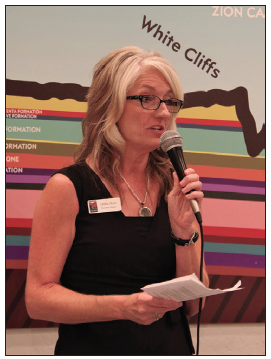Ribbon cutting at newly renovated John Wesley Powell Museum
- Phil Clark

- Aug 30, 2023
- 5 min read
On August 25, the Glen Canyon Conservancy hosted a Ribbon Cutting Ceremony inside the newly renovated John Wesley Powell Museum and Archives at 6 North Lake Powell Blvd in Page, Ariz. For most people in attendance, this was the first time to see the new exhibits inside the museum. Aramark catered the event with delicious food and drink. Other members and community leaders explored the new exhibits and caught up with friends and associates.
Left to right, photos by Phil Clark:
Deanna Smith cuts the ribbon while Page mayor Diak, Glen Canyon Conservancy Executive Director Debbie Moses, and Assistant Executive Director Connor Smith help hold the ribbon.
Executive Director Debbie Moses welcomes the guests at the ribbon cutting and talks about the exhibits and future plans for the museum.
Members and guests gaze at the restored map of the Colorado River drainage.
The museum is housed inside the original concrete testing laboratory, built in 1958 by the US Bureau of Reclamation (BOR) to test concrete cylinders during construction of the Glen Canyon Dam. In 1969, the John Wesley Powell Museum opened after the BOR no needed to test concrete. The brainchild of Stan Jones, the Museum has been one of the historical venues for visitors and locals for over 50 years. Over time the interior of the museum changed several times. In 2019 the Museum would have celebrated its 50th anniversary, had it not been for a sewage backup in the building that caused enough damage to require closure. Just before the closure, the museum hired Deanna Smith as museum curator and archivist. It was also ironic that the sewage spill happened the same year as the 150th anniversary of the first John Wesley Powell expedition down the Green and Colorado Rivers. Between the “flood” and the pandemic, the museum leadership decided to take advantage of the situation and closed the museum for renovation and repairs.
The interior was completely remodeled and upgraded. Smith led the exhibit planning and construction, assisted by Conservancy staff, volunteers and contractors. The result is a modern and elegant space where visitors and locals can learn about the history of the Page area, southern Utah and northern Arizona. Many of the interior walls have been removed making it feel larger than it used to be. The dioramas of Powell’s exploration of the Grand Canyon and the Dominguez- Escalante expedition, the only exhibits left from the old museum, have not moved. Pat Talbott, a local volunteer, skillfully restored the dioramas and they look better than ever.
Entering the museum reveals an exhibit by the Bureau of Land Management. Debbie Moses, Director of the Glen Canyon Conservancy, greeted the large group of around 67 people and talked about the partners and contributors to the museum. Her tour started with the question, “Who doesn’t want to see dinosaurs at a museum?” The BLM lent several fossils, including skulls, to the museum and is the first thing visitors see when entering the building.
Passing through the wide opening to the adjacent large room are several other exhibits. As one enters the room, what some call one of Page’s “treasures” comes into view. Many visitors and residents of Page remember the hand carved, detailed, three-dimensional model of Lake Powell and the surrounding land. The map was commissioned by the BOR in the early 1960s and was carved to scale (the vertical scale is slightly exaggerated) from foam with dental tools and painted by hand. It originally was housed at the Carl Hayden Visitor Center until 2015 when the BOR upgraded the exhibits there. The map, comprised of eight sections, was stored at the BOR warehouse in Page until the Conservancy agreed to display it in the Glen Canyon Conservancy Flagship Store, next to the John Wesley Powell Museum.
To prepare it for display in the museum, Pat Talbott meticulously cleaned, repaired and restored the model. Rob and Sara Peterson helped level the map with the assistance of Scott Harris, a local concrete contractor, who volunteered the use of a laser leveling device. Many commented how this is the best the map has ever looked. It is as if it now glows from the variety of colors representing the fractured landscape. As proof of Talbott’s high quality work, the seams between the panels are not visible. With the completed remodel of the building, Moses says that the map has “found its forever home.” Visitors to Page should count this map and the museum as one of the “must see” places in a tour of Page.
Other exhibits at the museum include “River Running” featuring the boat named “Mexican Hat II” from the Nevills Expedition. Norman Nevills explored the Colorado River in 1938 starting at Green River, Utah, descending the Green and Colorado rivers to Lake Mead. Elzada Clover, botanist at the University of Michigan, was on the expedition and was the first woman to travel down the Grand Canyon on the river.
An exhibit about the early days of Page explain to visitors how Page was founded in 1957 as the place for workers to live while they worked on the dam. An interactive screen allows visitors to learn even more. Along the hallway to the restrooms are aerial photographs of Page from 1960 to 1997. Those who have known Page over time will enjoy seeing how the town has changed.
“Manson Mesa History” describes the history of the mesa where Page was established and explains how Navajo rugs are created from sheep raised on the Navajo Nation with photographs and a rug pattern.
John Wesley Powell’s expeditions and exploration of the Green and Colorado Rivers as well as the Dominguez- Escalante expedition round the palette of exhibits offered to locals and visitors.
The exhibits don’t end in the museum. Online museum collections can be seen at http://5101.sydneyplus. com/final/Portal/Default.aspx?lang=en-US
Moses expressed her appreciation for all who volunteered to get things ready for the ribbon cutting and the grand reopening. A large mural of the “Geology of the Grand Staircase National Monument”, painted by local artist Maschelle Zia, representing the folded geologic layers that form the Monument, served as backdrop for the ribbon cutting. Deanna Smith cut a long red ribbon with a pair of large wooden scissors. The newly renovated John Wesley Powell Museum and Archives will be open to the public at their Grand Opening Celebration on Saturday, September 2, 2023.
The non-profit Conservancy operates nine visitor information and store facilities in southern Utah and northern Arizona and sponsors several events throughout the years. Members of the Conservancy have a number of benefits including merchandise discounts and discounts at other participating non-profit organizations in public lands. An annual membership is available for as little as $35. For more information, visit https://www.canyonconservancy. org/ membership.
Moses expressed her gratitude the Conservancy’s sponsors and partners including the National Park Service, Bureau of Land Management, the Canyon Club of Page and Aramark. Without the help of volunteers, members, donors and partners, the ribbon cutting might not have been a reality.
The Museum exhibits are not yet fully complete. The Conservancy welcomes volunteers, donors and sponsors to help complete the planned exhibits. Moses says that people can help the Conservancy in many ways including serving on the Board, volunteering to work in the museum and bookstore and donating time, money and unwanted vehicles. Those interested in supporting the Glen Canyon Conservancy or be a sponsor for the major exhibits should visit https://www.canyonconservancy.org/ support or contact Debbie Moses at 928- 640-3900.










